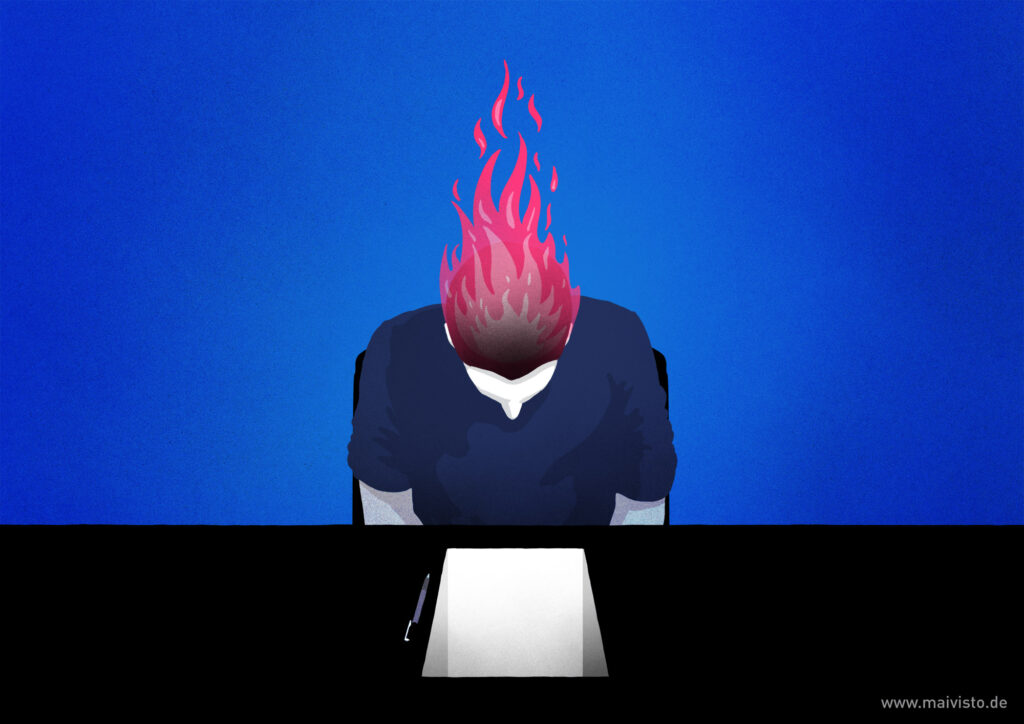
Frustration is usually perceived as something negative. In a way, it is. Who likes that uncomfortable burning feeling behind the chest when the drawing, the layout, or the story doesn’t look like we imagined it. In our minds, it looked already finished, so simple to accomplish.
I often heard the following sentence, especially from fellow students: “It’s already finished in my head. I just have to put it into practice.” This sentence expresses pure fear. Fear of starting and failing. The person is lying to herself.
She knows that it is not that easy. She already knows the pitfalls of creating. Our childhood is full of creative disappointments. The racing car we wanted to build with Lego looked clunky and uncool. The shack in the woods ended up being just a loose weave of sticks. We know precisely how hard it is to create something. The truth is no action, no work, no creativity.
Frustration kicks against the door and wants to stop us, mainly because something is important to us
We need to realize that frustration doesn’t just happen in the creative process. It is a part of it. It surfaces whenever we try to inject our inner selves into the world. This realization should reassure us, and for two reasons:
First, we prevent frustration from surprising us. It’s quite the opposite. We expect it to strike us even before we pick up the pen. Thus it loses its greatest terror. Second, we can use its power against it. We can use it as a compass. Frustration kicks against the door and wants to stop us, mainly because something is important to us.
Overcoming frustration is the step across the line from amateur to professional
Now we just have to decide: Do we care enough that we want to bite through the frustration with anger and eyes soaked with self-doubt (I guess that’s where the word “passion” comes from), or not? This moment is crucial. Overcoming frustration is the step across the line from amateur to professional. The amateur gives up here. He is a romantic who cannot handle resistance. He rededicates to more minor nerve-wracking things and only returns when he feels like it, only turning back again.
The professional goes into fight mode. During this time, people should avoid him. He is easily irritable, bad-tempered, and sometimes hardly recognizable. The professional demonstrates stamina here, like a marathon runner fighting side stitches. He has decided to take up the fight and outgrows himself. He says, “I’ve already rewritten the script three times, and I’ll do it a fourth.” “I won’t leave my apartment until I draw an eye I’m happy with.” “I’ll publish a blog post every day, come hell or high water.” “I’ll practice football headers until I’m no longer afraid of them.” The moment we decide to take up the fight, the urge to win is greater than the pain of frustration. When frustration hits us, we are on a promising way to finding our very own voice, which makes us an expert in our field and gives us the possibility to let our souls speak. In art, we say this, “She has her own unique style.”
Frustration is energy
Frustration is energy. When we face it and overcome it, we take this energy and transform it to our favor. We feel pride, relief, and confidence that we will make it again in the following situation. It has become our ally for the future.
On the other hand, we usually do not fight for something not close to our hearts. When we consciously decide not to go down the path, it is a valuable decision that guides us in our own way. When we say “No! I choose not to do it” (not to be confused with “No, I’d rather go play Playstation.”), we can turn our backs on the task with a clear conscience and keep searching until we finally find what worth all the frustration is. And when you find that, brace yourself against the inner terror with everything you’ve got.